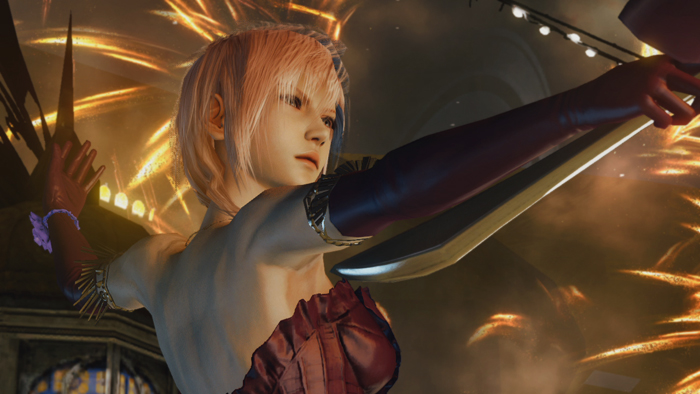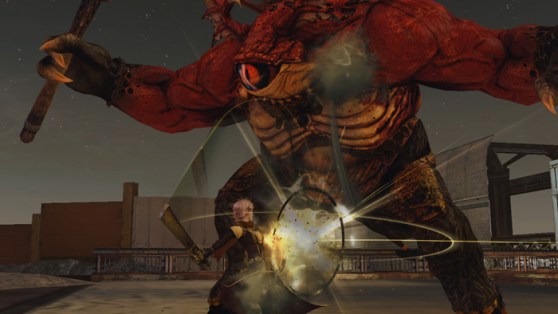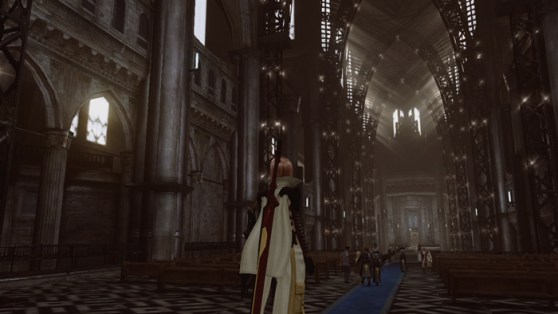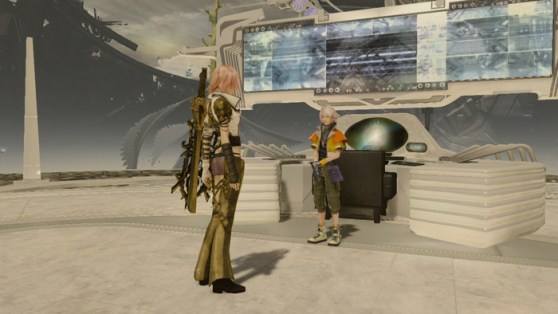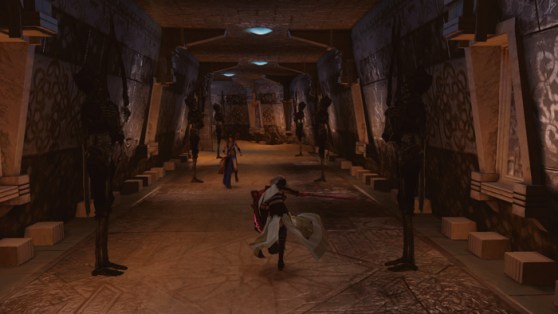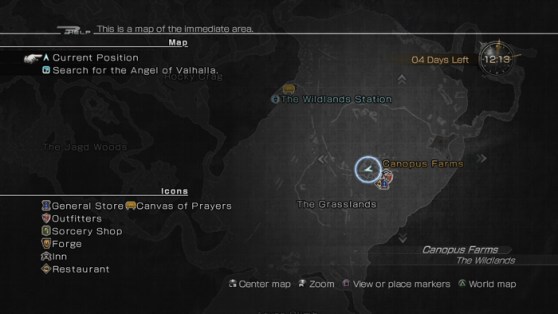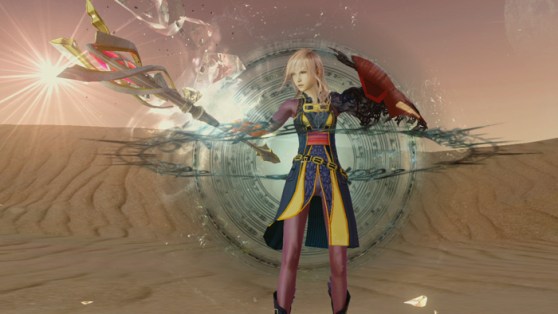Check out our Reviews Vault for past game reviews.
Lightning’s back, and she’s packing a mean closet.
Lightning Returns: Final Fantasy XIII is the third and final installment in Square Enix’s Final Fantasy XIII trilogy (due out today in North America on Xbox 360 and PlayStation 3, which I reviewed) and gives the warrior her biggest spotlight yet. The pink-haired Lightning has returned from her self-imposed crystal sleep at the end of Final Fantasy XIII-2 and is now the savior of the doomed world of Nova Crystallis. It’s a story that has gone from ridiculous to just plain impenetrable, but the armor-based battle system proves to be strong enough to counter most of Lightning Returns’ woes.
What you’ll like
A deadly wardrobe
Unlike all other Final Fantasy games, Lighting Returns features a solo hero, not a party of adventurers. But this doesn’t restrict her to one set of tactics. The class system in Lightning Returns has tweaked the XIII series’ Paradigm Shift to now rely entirely on its collectible armor sets called Schemata, customizable outfits in which each have their own statistical strengths. The Mist Wizard Schemata grants bonuses to magical offense, and the Sacred Knight schemata boosts a mastery of guarding maneuvers. Similar to how each character in prior titles in the trilogy could switch between healer, tank, or offensive roles on the fly, Lightning can perform an instant wardrobe change when you require a different tactic.
You can purchase or find dozens of these Schemata and equip with any combination of swords, shields, accessories, and abilities. Lightning can then switch between any three of these armor sets at any time during battle. Maximizing the efficiency of your go-to schemata requires a lot of menu surfing, but it rarely feels like a grind. That’s largely due to how open the system is to player control and preference.
Aside from a few ingrained stat bonuses, you can attach any ability or weapon to any Schemata with varying effectiveness. Finding a new Schemata with a boost toward your favorite spell and balancing it with an HP-buffing shield gives you a feeling of ownership. A ton of cosmetic objects, while providing no effect on battle readiness, draw you deeper into the process of accessorizing than you would imagine. It’s a shallow but undeniable joy to have your poison-resistant Warrior Schemata dishing out pain from behind a giant pumpkin head.
An Active Time Battle system that actually feels active
Unlike the oft-criticized Paradigm battle systems of the prior two Final Fantasy XIII installments, Lightning Returns boasts more immediate and strategic combat. You still must find and exploit the elemental and/or status ailment weakness of your enemies, but a well-balanced timing system gives combat an impressively sharp, strategic edge. Each command takes up a portion of a Schemata’s Active Time Battle gauge, stronger actions taking more than basic maneuvers. Once depleted, the ATB gauge must recharge — at least partially — before you can execute another command. Each Schemata has its own ATB gauge, making flitting between the three setups absolutely crucial if you don’t want to leave Lightning open to receiving full damage.
Like in Final Fantasy XIII and XIII-2, landing successive blows on an enemy builds up a Stagger gauge that will knock an opponent off-balance and greatly diminish its defenses. Once active, the gauge will constantly deplete unless maintained through consistent damage. Attacking with the right commands — or guarding at the exact moment of an enemy’s attack — is the only way to maximizing a Stagger. This frequently requires stacking the best attacks from all three of your active Schemata, frantically swapping between them while blocking against your enemy’s onslaught and making time for the occasional heal. It’s tough, and your survival begins to rely on the exploitation of these Stagger gauges fairly early on.
Lightning Returns is by no means a forgiving game. Square Enix has been recommending the Easy difficulty, and I am inclined to agree for players not wanting to spend hours tailoring Schemata to each boss encounter. A definite satisfaction can be had in defeating some of the more tenacious foes on the standard difficulty, especially when your manage to time a move perfectly for that Stagger gauge-busting moment. The combat here is tough but always balanced toward the player, and it maintains a gratifying challenge throughout the average 40-hour run.
A palpable, inevitable cataclysm
I wasn’t exaggerating when I called Lightning Nova Crystallis’ savior. The lithe warrior maiden returns to the world 500 years in the future thanks to the god of light, Bhunivelze (a being who’s simply referred to as “God” in the dialogue fairly often). Time stopped due to events earlier in the series, making the citizens of the world effectively immortal — only accidents, disease, or murder would kill them. Children remain in their prepubescent bodies, and even the strongest bonds have begun to strain after the long centuries.
This global stagnation is expertly brought to life through the art direction. Densely packed marketplaces overflow with the clutter that results from centuries of neglect, and idle NPC chatter comes in a wide variety of comfortably numb sentiment. This world is doomed, and its people all know it. The mood picks up during action-heavy scenes, but for the most part this is a somber adventure.
Lightning has 13 days to save as many souls as possible through her quests, storing them as something known as Eradia energy to be reborn in God’s new world. You begin with less than a week on the clock, and you must collect enough of this Eradia to extend the world’s remaining time up to 13 days. As savior, Lightning has the ability to freeze time temporarily, but you will still need to manage each day wisely to maximize the amount of quests you complete and Eradia you gain.
The real triumph of Square’s treatment of this apocalypse is in these moments of individual redemption. The constant time limit forces you to weigh the merit of each soul to be saved, and the way most characters relate to the end of the world speaks to a mature understanding of end-of-life psychology. After 500 boring years, most have stopped begging for salvation. They are just tired, and once you save their souls, they generally welcome death.
What you won’t like
A story dumped on your lap entirely through exposition
The benefits of having a universe with complicated internal mythologies and cultural nuance vaporize when you need to spoon feed everything within that universe to your audience. Lightning Returns may set a new record for the most exposition-dense conversations ever in a video game, both overall and in EPM (explanations per minute, a rate I just made up).
Having characters speak in “As you already know…” monologues is one thing, but then having the other person in the conversation rephrase the exact same thing with just as little emotion is an entirely new form of tripping over oneself. The conversations between Lightning and Hope (a returning Final Fantasy XIII and XIII-2 cast member repurposed as God’s eyes and ears) are particularly grating. Not only is each of your 13 days bookended by drawn out bits of the characters effectively reading from the in-game dictionary, but Hope acts as a horrifying mix of Metal Gear Solid’s Otacon and The Legend of Zelda: Ocarina of Time’s Navi while Lightning is out soul-collecting.
Whatever interesting world-building that goes on during quests is ruined when Hope pipes up via God Bluetooth to tell Lightning exactly where to go, what to do, and who to speak to, all before repeating the last 30 seconds of NPC dialogue. It doesn’t matter that the game’s four main locations are sprawling swathes of land open for exploration; Square still doesn’t trust players to know what to do with their limited time.
The result is more disheartening than aggravating. Lightning Returns is teasing us with some heavy material: global immortal ennui, the unbelievable pressures of being a savior, and a capital “g” God preparing to end it all. But it all throws up on itself almost instantly with unnecessarily dense dialogue from characters that sound like they’d rather be anywhere else. The story provides a reason for why Lightning is genuinely stripped of emotion, but that doesn’t make spending dozens of hours with her any more bearable. It manages to scrape together enough emotional attachment for one hell of a finale (and the character of Lumina is an entertaining mix of bubbly preteen and potential spawn of evil), but it is nowhere near enough to counteract the drudgery.
A world of wasted space and confusing mazes
Places come in two flavors in Lightning Returns: needlessly open and frustratingly dense. The two urban spaces, Luxerion and Yusnaan, fare well enough thanks to the aforementioned art direction. But the plains of the Wildlands and the Dead Dunes desert contain both gratuitously stretched out center areas and frustratingly convoluted winding roads.
The Dead Dunes is the worse of the two, with an underground dungeon of time-locked doors that force you to constantly be opening and closing the menu screen in confusion. It, alongside the Wildlands’ intersecting forests, was designed more to waste time than anything else. These areas have been purposefully laid out to consume as much of your 13 days as possible, and they funnel more than a few unwanted monster encounters directly into your face. You can manage to avoid repeating the time sink by activating teleport locations, but you’ll be so burnt out with these locations that you’ll rarely want to (or need to) return.
A new kind of forced grinding
Thirteen days doesn’t feel like a long time, but Lightning Returns will have you making the most of it, and not always in a good way. It ties progression to quests, not battle victories. Everything from fetch quests — listed on a Prayer Board next to an annoying woman in a Chocobo outfit — to the five main quests net gains in health, magic, strength and EP slots (Lightning’s special savior abilities that enable her to slow down time, deal massive damage, or instantly teleport around the world map). Stronger abilities and higher-ranked spells may also appear as rewards at the end of the more involved quests.
This means that if you want to be in any condition to complete the more difficult missions, let alone the end game, these optional side objectives just became mandatory. Thankfully, you can achieve most of the minor quests en route to larger objectives, but be prepared to find thing X (usually by defeating monster Y) to give to person Z more times than you’ll be comfortable with. It doesn’t help that many quests are time-locked and specific to one of the four regions, forcing either a lot of wasted time on trains or precious EP spent on instant transportation.
Conclusion
Lightning Returns: Final Fantasy XIII has enough to engage you that you will care about how much better it all could have been. The art design tells a much stronger story than the text boxes disguised as characters, but you’ll be far too busy finding and swapping your new favorite Schemata to care. This is the most satisfying battle system the series has had since Final Fantasy X, and it stands strong enough on its own to merit a recommendation for most players.
But if that’s not enough for you, don’t worry. It’s not the end of the world.
Score: 65/100
Lightning Returns: Final Fantasy XIII releases on Xbox 360 and PlayStation 3 on Feb. 11, 2014. The publisher provided GamesBeat with a prerelease PS3 copy for the purposes of this review.
VentureBeat's mission is to be a digital town square for technical decision-makers to gain knowledge about transformative enterprise technology and transact. Learn More
